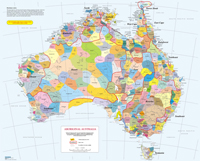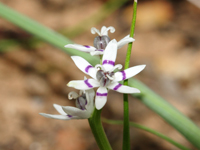I’m a little sheepish about today’s story.
Common Blackbirds are not a native species, one of the first birds of European origin that was deliberately brought to Australia, introduced to Melbourne in the 1850s.
It is just one of a host of exotic species established in Australia and ranks with the House Sparrow and Common Starling in terms of its spread across the eastern half of the continent. While blackbirds favour urban environments they will establish anywhere that provides sufficient cover and can be found in bushland remnants across the district. This one, a male, is just one of many in the neighbourhood – pictured here feeding on olive fruits in our front garden. While no doubt responsible for the spread of European Olive the ‘horse has well and truly bolted’ and both species are here to stay.
I’ve included a couple of Crimson Rosella portraits to balance the ledger … although their perch of choice is a Claret Ash!

Common Blackbird raiding olives, Wyndham Street Newstead, 3rd May 2020

II

III

Immature Crimson Rosella

II
Footnote: Peter Cuffley kindly provided this information on Claret Ash.
As a keen social historian, I thought you would be interested in the attached item I found while researching the Austin family in Victoria and Somerset. Brothers James and Thomas Austin, after migrating from Somerset to Tasmania in 1837, moved across to Geelong and district. They both acquired or leased large areas of land and in 1851 James was the second mayor of Geelong. Having made his fortune, in 1856 he went back to Somerset and purchased the historic Glastonbury Abbey estate. In 1861 his brother Thomas and his family travelled to Glastonbury and lived there until their return to Victoria in 1864. His letter to the Acclimatisation Society of Victoria is an interesting document, especially his bizarre statement, ‘and the wild English rabbit I have in thousands.’ While he is often blamed for all of our rabbits, they were actually introduced in earlier decades. Strangely, the rabbit was not native to England as suggested in the letter, but was introduced by the Romans. It is thought they were established in the wild in Britain by the 12th century. Thomas Austin died in 1871 and his wife Elizabeth went on to found the Austin Hospital.
While the Claret Ash, Fraxinus oxycarpa ‘Raywood’ is not indigenous to Australia, it does qualify as a kind of ‘honorary Australian’ tree! It is a seeding variant discovered circa 1910 in a group of assorted Ash trees at a nursery at Aldgate in South Australia’s Mount Lofty Ranges. Tullie Cornthwaite Wollaston and his gardener Mr. J. Gates purchased the plum coloured ash and planted it at ‘Raywood’, Wollaston’s property at Bridgewater. All of the Claret Ash trees in Australia and overseas are clones of that one seedling. The property ‘Raywood’ was developed from the 1930’s as ‘Arbury Park’ by the Downer family. I photographed the house and garden in 1984 and it is in my book, Traditional Gardens in Australia.
Many thanks Peter!


































































